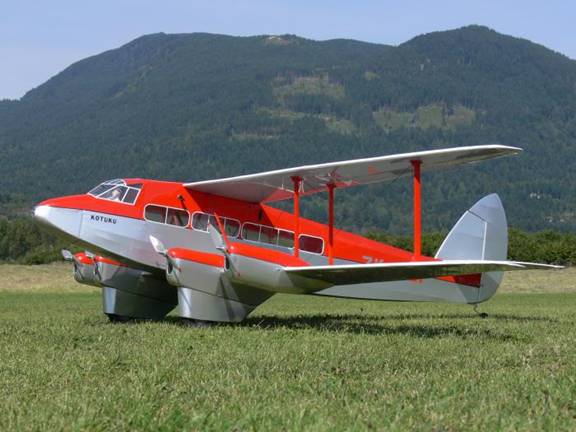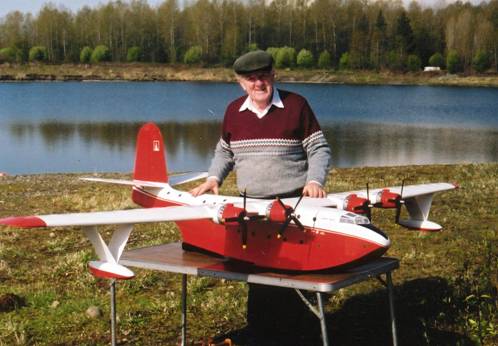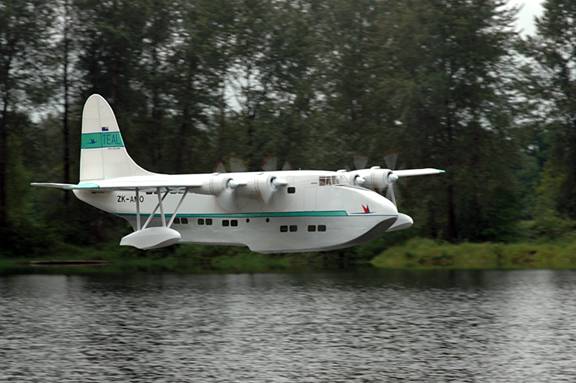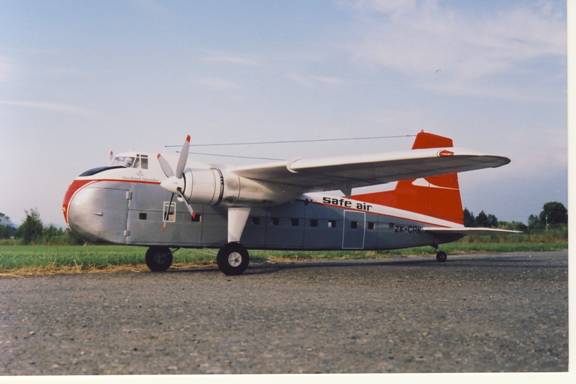
July 29, 2012
With permission from: Ivan Pettigrew
Models of Multi Engine planes always create a lot of interest, possibly because they are not often seen. With gas engines it is difficult to get two engines started and running reliably. If both engines keep running, a multi engine model is no more difficult to fly than a single. But when one engine stops, as frequently happens in a gas powered twin, the flyer suddenly finds out why multi engine pilots spend so much time, in ground school and flight training, learning how to tame an aircraft that only has power on one side. With electric models we don't have the start up problem, and the chance of a motor failing in flight is very unlikely. It does happen though, but if the model flyer knows to reduce power and keep the airspeed up, there is no problem with landing. It is the excessive use of power at low airspeed that makes twins such a handful. Most electric flyers have had a glider at one stage, and a twin flying at reduced power on one motor is just like a glider. When the landing is assured, any partial power left on one motor can be reduced and the model landed safely. In my experience, the usual reason for power loss in an electric twin has been the pinion gear on the motor shaft coming lose. It has happened to me maybe two or three times in ten years of flying electric twins and has never resulted in an accident.
Multi engine aircraft are usually larger and don't appear to be flying very fast. Hence, for realism, models need to be kept very light, and scale appearance in flight is easier to achieve by making the model quite large. Multi engine gas models have to be built heavy so the airframe can absorb all the vibration of the engines. The resulting high speed they fly at does not look too impressive to most intelligent observers. Multi motor electric models can be built extremely light, almost akin to the free flight rubber powered models of the past. The slow realistic flight of large electric twins is what impresses most first time observers.
My inspiration for electric twins came from reading an article written by Keith Shaw in the early nineties. For some years the unfinished fuselage of a Catalina flying had been lying in the rafters of my workshop. It had started off to be a gas model, but I had never managed to get two suitable engines for it. Suddenly the light went on, and I renewed my interest in the Catalina. At that time the popular model was the "05" can motor used in so many electric gliders. It is the same size as the Speed 600 motors. The nicads that were used were "C" size of 1400 mAH capacity. The motors were wired parallel and ran off nine cells. Eight cells was considered the safe limit for those motors, but with two motors parallel, the added load reduced the voltage to what it would be for a single motor operating on eight cells. The model had a span of 75 inches and wing area of 724 square inches and weighed 87 ounces resulting in a wing loading in excess of 17 oz/sq.ft. It flew quite well from a hand launch, and would even take off from land on a dolly. But the flight time was not too impressive. Mistake #1 was building the model too heavy, and too small.
The wings of the Catalina were cut and lengthened to 81 inches. This reduced the wing loading, but mistake #2 surfaced. The model was less stable. The moment arm and tail surfaces needed to be increased in the same proportion as the wing extension. A stretch job was done on the fuselage and the Series 300 emerged. Having the fuselage cut in half allowed me to remove a lot of wood from that original design for a gas model. Eventually the wing loading came down to 16.8 oz/sq/ft, but the first attempt at taking off from water was hopeless. For that story, read the article on designing flying boats. When lesson #3 about wing incidence was figured out, the beast would get off the water if it could be kept straight while getting on the step.
Flights were still a bit on the short side at only 5 minutes or so. It seemed that adding more cells and wiring the motors in series would be the answer. Mistake #4. Flight duration was up, yes, but so was the weight. The hull was so far down in the water that on take off, spray was sucked up into the propellers and slowed the motors, making it very difficult to get up on the step. This process went on for a few years. I am a slow learner! The answer came in two ways. I sold the Catalina and recommended lighter Sanyo 1000 SCR cells. It handled the reduced weight of the smaller cells very well and still had good endurance. But the solution for me was to build a new Catalina, the present one, which is larger in size with more wing area and flotation, but lighter construction. It has been a winner since day one.
My next twin was a Beaufighter. By that time I was finding that "05" car motors were better than the can motors, being more powerful, and having a much longer life. The Beaufighter had retracts and flew up to 6 minutes on 10 cells with the motors wired parallel. The next experiment was to cram 16 cells into the Beaufighter and wire the motors in series. The first flight was a greater disaster than trying the Catalina off water. Because of the increased battery weight, it ran on the grass field forever and finally staggered into the air in an overload condition. I was afraid to turn back until I could get some reserve airspeed, but before that could be achieved the thing tip stalled and spewed nicads all over the field. Lesson # 5 is that when motors are wired in series, radio interference can become a real problem. Besides more brush noise, there seems to be a reaction between one motor and the other caused by spikes of reverse back EMF. Remember that from high school physics days? The cure is to put a Schotky diode across the motor terminals when motors are wired in series. It does not appear to be necessary when the motors are parallel. Getting back to the Beaufighter, it was eventually stretched in two dimensions a la Catalina. But the final fix was to build a lighter one at a larger size, and it is an awesome performer.

The DH 89 Rapide was another learning experience. It started out as a design for 16 cells with motors wired in series. Endurance was good, but flight speed was a bit more than what I would have liked for scale appearance. I tried nine cells with motors wired parallel. It was so much more pleasant to fly at the lighter weight, and it started to float around the circuit at the speed of a full scale Rapide instead of a Gladiator biplane fighter. I thought that I would sacrifice some endurance by reducing the number of cells, but it did not seem to change much. It seems that much less power is needed to fly the model at the reduced wing loading. It will still do loops and stall turns on nine cells, but forget about rolls.
The first DH 88 Comet was designed for 16 cells and used can motors. Early in its life it suffered a mid air at a fly-in at Seattle. By that time I wished it had more wing area, so the rebuild gave me the opportunity to increase the wing area. With a stretch job to the fuselage it turned out to be a great flyer. Later I built a second Comet and got things right from the start. By then I was finding that the 16 turn racing car motors driving a very course pitch prop through a high ratio reduction drive gave great performance for faster flying models, so the Comet was increased to 18 cells.
The first Mosquito PR was on the small side for an old guy with failing eyesight and slowing reflexes. It had the same motors and battery set up as the Comet, but with higher ratio boxes and larger props. The speed was awesome, as were the size of the loops, but in military colours it was hard for the old guy to keep in sight. In spite of having flaps, the landing speed was a bit on the high side for the size of our local flying field. A second model was built with the same power set up as the smaller one, but in the red and white colours of the Mosquito T-III trainer. Weight was kept to the same as the smaller model, partially by not fitting flaps which are not so necessary at the much lower wing loading. It is delightful to fly. Doing a half loop on take off with roll off the top is quite impressive in this Mosquito. And this one I can see in flight!
Four engine models are even more impressive than twins, but not so much fun, since I'm told that four engine planes don't do aerobatics. Don't believe it. The first attempt was a Lancaster in 1996. By then I had this weight and size thing pretty well figured out, but maybe not the motors. I used those old Speed 600 type can motors and ran all four in series from 26 cells. That was the limit for the Ace 26/35 speed control that was being used, and equated to 6 1/2 cells per motor. In those days can motors usually ran on six or seven cells, so that was a good compromise. It flew on that set up for a few years. Learning that car motors flew very well on nine cells, and were very efficient on low amperage, I installed four 27 turn stock car motors with high ratio boxes driving the same original 13 inch props. But the motors were now wired in series-parallel to 18 cells. This equated to nine cells per motor. They were very efficient in this set up and gave considerably more power than the original motors on 26 cells. Again I thought that endurance would suffer, but not so. There was a considerable reduction in battery weight, and the car motors are lighter than the can motors. With the reduced weight, the Lancaster climbed much better, flew with more power reduction, and was all around a much nicer model to fly. The flight endurance did not seem to suffer with the cell reduction. Since then the very efficient 22 turn Magnetic Mayhem reverse motors have come on the scene and give even better performance, quite apart from the better choice of batteries that we now have.

The next four-motor project was the Martin Mars flying boat. I wanted to use up those four old can motors that were taken out of the Lancaster, so the Mars was designed for that purpose. Not having to carry the weight of retracts, it could be built lighter, which also means larger. In retrospect, the thing could have been larger because it has loads of reserve performance, but transportation becomes an issue at this size. The motors are wired series-parallel from 18 cells, though it flies quite well on sixteen. One advantage of series wiring in a flying boat is that it is very easy to incorporate differential power to the motors. In float planes, a water rudder is used to help with directional control on the water, but in multi engine flying boats this is done by use of differential power to the engines.. This is necessary when there is any amount of wind present. If micro switches are placed on the rudder servo in such a way that they close when the stop is reached, these switches can be wired to place a very low resistance across the terminals of the inboard motor/s. It effectively slows the inboard motor/s and at the same time increases the speed of the outboard ones. This set up is used on the Catalina and Mars and works very well. To avoid smoke pollution, full rudder stall turns should not be done at high power! But at taxi power it is OK.

Photo Credit - Beverly Hudson "Team Tracon"
The Magnetic Mayhem motors have proven to be very efficient on nine cells at low power such as in the 15 to 20 amp range. To exploit the possibility of using these, the Short Sealand was designed to use two of these motors wired parallel from a nine cell pack. The Sealand has turned out to be a great flyer and will fly for 15 minutes on a pack of nine 3,000 mAH NiMH cells. It was never intended for aerobatics, but is really outstanding, almost as good as the Mosquito. The performance is too good for a flying boat, so a land plane was recently designed to use the same power set up and configuration. It is a Partenavia, and is up to every expectation. When flown with ten cells it is even better, and can do the same take off routine as the Mosquito. When it lands the motors are still cold. To me, that spells efficiency. The Partenavia was designed to be an easy built introduction to twins. North Americans would call it "Multi 101." With a rectangular wing and box fuselage it goes together too fast. The fun is over in no time. The landing gear is ideal for rough field operation and I will give a medal to the first person who can ding a prop on it. It should be good on floats too.

I almost forgot the Freighter. Pilots of the Freighter used to say it was like flying a two storied house from the upstairs bathroom. With those 16 turn motors turning four blade 15 inch props through a 7:1 reductions from 16 or 18 cells, it is a giant sized park flyer. Large slotted flaps reduce the landing to a crawl. In 2,000 it took first place in the Canadian Nationals in electric stand off scale. Don't ask me where to get four blade props. Buy regular two blade props, notch them at the centre, and bolt them on to the shaft, crossed at 90 degrees. They don't need to be glued together.
A new venture was into a model using the impressive GWS Speed 400 geared drive with the light 9" x 7" three blade props that GWS also make. The result was the Solent flying boat. It flies every bit as good as it looks, and like the Sealand will do 15 minutes on nine 3,000 NiMH cells. The motors are all parallel from one single pack. With nicads it is actually overpowed with nine cells, so is regularly flown with eight cells. It is a great size for ease of transportation. The motors are a bonus too. At $17 each, four of those motor gearbox combinations on the Solent come out at less cost than the two motors used in the Sealand.
So where do we end up? Series or parallel? It is time to cast your votes. In the old days when large cells with high discharge rates were not available, it was better to go with more cells and series wiring when more power was needed. It required a speed control that would handle the higher number of cells, but it didn't have to handle an extremely high amperage. With the larger cells now available that are capable of high current output, it is simpler in many cases to wire the motors in parallel, using less cells, but requiring a speed control that can handle the higher amperage. If you are afraid of an electrical failure in the motor of your twin, what is better, series or parallel. With a series set up, if one motor fails, such as by having the wire come off a motor terminal, the circuit will be broken and the other motor will stop. It will be a dead stick landing. If this happens in a parallel set up, you will still have power on the other motor, but go easy with it, and reduce power if you are running out of rudder control to check the yaw. There you have it. Take your choice.
Something that should be avoided in multi motor electrics is using outboard aileron servos. The long servo leads would be running parallel to the motor wiring and prone to picking up radio interference. All motor wiring should be kept as short as possible, and the radio gear and servos are best kept as far back as possible in the wing opening of the fuselage. The speed control and motor wiring should be placed well forward.
No doubt many will ask why I have not mentioned brushless motors. My nickname among the local modelers is "Low Tech Ivan." With brushless motors in a multi engine model, it seems that it is necessary to use separate controllers for each motor, and the price would be pretty steep. Good luck if you can afford that. I find that with multis, the motors are running at lower power where both the efficiency and life expectancy are all the one could wish for. I bought my first 16 turn racing car motor ten years ago, have had it in constant use, and it is still performing well. Maybe every hundred flights or so the brushes need to be change, but that is very simple. Some of the batteries that "Low Tech Ivan" is using are getting as old as that sixteen turn motor, but new batteries are another thing, and can enhance the performance of any model. All the stats that I give for my models can be improved on with newer batteries. Give me your "cast off" nicads & I will fly with a smile on my face forever.
And what has "LT" Ivan learned in twelve years of tinkering with Multis. Not very much! As I penned the above notes, I was horrified to see the similarity between the first multi, the original Catalina, and the latest twin, the Partenavia. Each flew on nine "C" cells. The Catalina had a wing area of 724 sq.in and the Partenavia 730 sq.in. Have we come full circle? In terms of performance there is a world of difference between the two models. To add insult to injury, by next multi project is hopefully another Catalina, and yes, back to the size of the original one, and running off nine cells! But it will use those great little GWS Speed 400 geared drives, and hopefully be a real floater. It is a game of efficiency which involves weight, types of motors, batteries, airfoils and so on down the list. That is what makes the game challenging and keeps up the interest. Try the challenge of electric multis for yourself and get that infectious smile on your face.
Update 2008. The descriptions and specs for most of the models were written before Li-Poly batteries came in to use. With Li-Po batteries, the weight and wing loading of the models will be lighter than the figures shown, and performance will be enhanced. Where a nine cell pack was originally used, a 3S Li-Po battery should be used, preferably of larger capacity. Flight time will be considerably longer, not only because of extra battery capacity, but because of the weight saving.